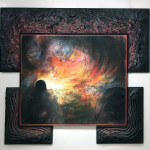Biography
Robert Morris (1931-2018)
Born in 1931 in Kansas City, Missouri, Robert Morris turned to art and art criticism after studying engineering, eventually writing a 1966 master’s thesis on Constantin Brancusi at Hunter College, New York. Since then, Morris has continued to write influential critical essays, four of which serve as a thumbnail chronology of his most important work: task-oriented dance (“Some Notes on Dance,” 1965), Minimalist sculpture (“Notes on Sculpture,” 1968), Process art (“Anti Form,” 1968), and Earthworks (“Aligned with Nazca,” 1975).
During the 1950s, Morris grew interested in dance while living in San Francisco with his wife, the dancer and choreographer Simone Forti. After moving to New York in 1959, they participated in a loose-knit confederation of dancers known as the Judson Dance Theater, for which Morris choreographed a number of works, including Arizona (1963), 21.3 (1964), Site(1964), and Waterman Switch (1965).
During the 1960s and 1970s, Morris played a central role in defining three principal artistic movements of the period: Minimalist sculpture, Process Art, and Earthworks. In fact, Morris created his earliest Minimalist objects as props for his dance performances—hence the rudimentary wooden construction of these boxlike forms, which reflected the Judson Dance Theater’s emphasis on function over expression. Morris exhibited entire rooms of these nondescript architectural elements at the Green Gallery, New York, in 1964 and 1965. In the latter half of the 1960s, Morris explored more elaborate industrial processes for his Minimalist sculpture, using materials such as aluminum and steel mesh. Like these industrial fabrications, a series of Neo-Dada sculptures Morris created in the 1960s also challenged the myth of artistic self-expression. These included ironic “self-portraits” consisting of sculpted brains and electroencephalogram readouts as well as other works directly inspired by Marcel Duchamp’s quasi-scientific investigations of perception and measurement.
In the late 1960s and 1970s, the rigid plywood and steel of Morris’s Minimalist works gave way to the soft materials of his experiments with Process Art. Primary among these materials was felt, which Morris piled, stacked, and hung from the wall in a series of works that investigated the effects of gravity and stress on ordinary materials. A variety of these felt works were shown in 1968 at the Leo Castelli Gallery, New York. Subsequent projects Morris made during the late 1960s and early 1970s include indoor installations of such unorthodox materials as dirt and thread waste, which resisted deliberate shaping into predetermined forms, and monumental outdoor Earthworks. Since the 1970s, Morris has explored such varied mediums as blindfolded drawings, mirror installations, encaustic paintings, and plaster and fiberglass castings, and themes ranging from nuclear holocaust to Ludwig Wittgenstein’s Philosophical Investigations.
Numerous museums have hosted solo exhibitions of his work, including Whitney Museum of American Art in New York (1970), the Art Institute of Chicago (1980), the Chicago Museum of Contemporary Art (1986), and Washington, D.C.’s Corcoran Gallery of Art (1990). In 1994, the Solomon R. Guggenheim Museum, New York, organized a major retrospective of the artist’s work, which traveled to the Deichtorhallen in Hamburg and the Musée National d’Art Moderne in Paris. He lived in New York City and Gardiner, New York.

 Untitled
Untitled